Gathering Elderflower: Everything you need to know
Written by Elspeth Biltoft
The Elder is one of the most recognizable and readily available shrubby native trees to be found in Britain. It's flowers are easy to identify and straightforward to gather and their unique and powerful flavour make drinks and desserts of a truly superb quality.
How do you recognize Elderflowers?
Elderflowers come from the Elder tree, which is generally described as a shrub. Their young growth is bright green, mature stems light brown and the bark of the trunk deeply furrowed. The leaves are feather shaped with slightly serrated edges and set opposite each other in pairs of two or three, with a leaf at the tip of each twig. The flowers are unmistakable, like flat, open umbrellas between ten and twenty centimetres in diameter. That said they are similar at a glance to the Mountain Ash, but comparing both online before setting out to forage will demonstrate the difference. Each flower head is covered in tiny, creamy white flowers with yellow stamens. The scent is the best guide of all - muscat, sweet, heady and incredibly rich - lingering for hours in your fridge or larder.
When are Elderflowers in season?
Elderflowers bloom in late May, early June in the UK, depending on the weather.
Where are they found?
They are found in hedgerows, on abandoned railway lines, urban wasteland and close to redundant dwellings, farm and industrial buildings.
Are Elderflowers and Elderberries the same plant?
Yes the Elderflowers develop into small black berries in early autumn, so if you strip a bush of its flowers in spring there will be no berries to be had in late August.
How and when to pick?
Elderflowers are best picked on warm sunny days in June when the dew has evaporated and the flowers are fully open, creamy white and with yellow stamens. Older blossoms have a greyish hue and drop their petals easily - these have lost their potency and should not be collected. Using kitchen scissors clip the flower heads from the top of the stem, discarding any bitter tasting leaves. Gather the blossoms in a large bowl, colander or basket, rather than a carrier bag to avoid crushing. They should be used as soon as possible to retain their fine flavour, although they can be refrigerated for one night in a lightly covered container.
What parts of the plant are edible?
The Elder provides two crops to forage, one of flowers and the other berries.
What is the best use for Elderflowers?
Elderflowers make the most wonderful cordial, sorbet and 'Champagne', and in combination with seasonal Gooseberries, lovely jam and fruit fools. The berries make a very good simple cordial too. Check online, in books and magazines for numerous seasonal recipes.
Footnote on Foraging for Elderflowers
Please follow foraging 'rules'. Whilst gathering take care not to damage the Elder bushes, they have fragile stems, or surrounding habitat by trampling over it. Pick a little from here and there rather than stripping a bush, remembering that flowers develop into berries and provide food for birds. Get permission to pick on private land. Pick far away from the fumes of traffic.
Shop the related products:


